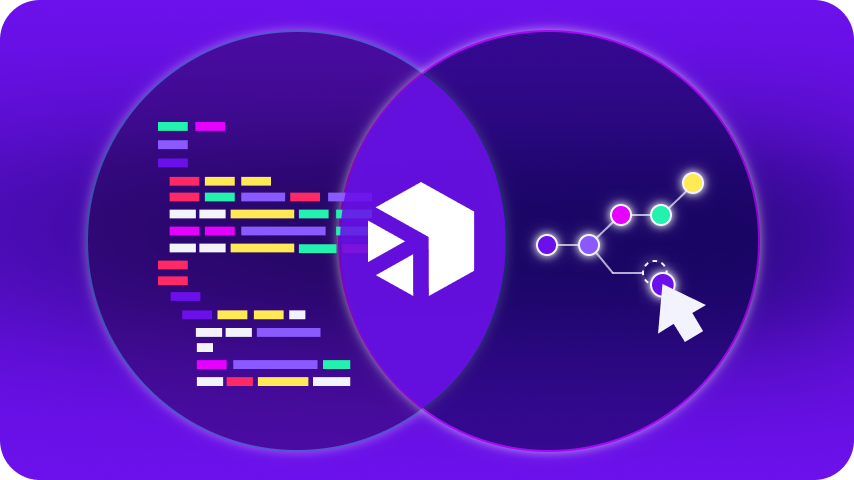March 2, 2023
Are your professional developers spending all of their time writing tedious code for in-house IT integrations? Or maybe they are spending hundreds of hours on training and certification for traditional enterprise integration platform-as-a-service (enterprise iPaaS) solutions, when they could be spending their costly time on more valuable pursuits for the company.
As you contemplate your enterprise integration strategy, you need to consider all of the factors involved. These can include the technical abilities of your current staff, your available resources, the project’s total economic impact and return on investment (platform ROI), and how much time you can dedicate to the IT integration project – at each stage of the ‘build, run, monitor’ process. In developing your integration strategy, one of the first steps is determining what type of IT integration solution is best for your business.
Selecting an IT Integration Solution That’s Right For Your Business: Pro-Code or Low-Code?
Before making big decisions regarding your IT integration strategy, you should recognize the competing priorities of IT integrations, and understand the different types of integrations and their pro-code versus low-code requirements.
There are generally three types of integration solutions; each with different coding requirements:
- In-house (pro-code) – IT integrations created internally from scratch, requiring highly-skilled professional code (pro-code) developers to handle the entire build, run, monitor integration process.
- Traditional eiPaaS (pro-code) – Traditional IT integration solution providers require highly-skilled software engineers and developers with specialized training and certification.
- Digibee’s eiPaaS (low-code) – Digibee’s low-code eiPaaS enables the entire IT team, with no need for specialized training or costly certification. This reduces IT integration costs and accelerates time to value because junior developers can handle the heavy-lifting, while senior developers can focus on higher-priority projects, according to Digibee’s report, 5 (+1) Reasons to Choose a Modern Integration Solution.
Let’s look at each type in detail to figure out the best choice for your company.
In-House Pro-Code: Why Your Internal Developer Team May Be Reluctant to Outsource What IT Does Best
Many companies default to building and maintaining their own IT integration solutions with in-house professional coders (pro-code). They may have internal software developers and engineers who take pride in building home-grown IT solutions, and are often eager to tackle a large project such as a multi-faceted integration implementation.
However, according to Digibee’s report, ‘How to Decide on an Integration Strategy’, this type of traditional internal/home-grown approach can create some serious risks and challenges:
- Significant time spent on IT integrations rather than other important corporate IT projects with high-value outcomes.
- Internal knowledge creates a single point of failure. If only a select few internal stakeholders understand the inner-workings of the system, that exposes the business to significant risk if the knowledge is lost because someone leaves the company.
- The growing complexity of your tech stack directly affects how complex your internal integration solution needs to be in order to scale with the growth of your company.
- The scope can quickly get out of hand as internal IT specialists build integrations from scratch with increasing levels of complexity.
Perhaps the greatest risk is that the global IT skills shortage is making it more difficult to maintain an internal team of expert developers who can write professional code (pro-code) with increasing complexity.
Traditional Integration Providers Still Need Pro-Code Developers
Selecting the right integration platform is an important decision that requires diligence, time, and patience. You may have thought that choosing a traditional provider would be the quickest, easiest route to integration, especially if you already have an established partnership relationship.
However, you may not have realized or considered that traditional integration solutions still require pro-code development and considerable time. The months-long implementation and upskilling for specialized training or certification, along with your stagnant and ever-growing IT backlog, may have you increasingly frustrated, and second-guessing your decision to go with a traditional integration solution provider.
Digibee’s Low-Code Platform Reduces Risks and Accelerates Time to Value
Any software developer can write code – that’s often their ‘happy place’ – but what about planning and preparing for when things go wrong?
Digibee embraces DevOps principals natively within our low-code platform, reducing errors and the overall risk of failure. Your company still has the agility it needs to scale quickly and easily with a user-friendly low-code platform, and you also have visibility, insight, and oversight of the entire integration system. Plus, you can experience faster time to value.
Here’s how Digibee’s low-code platform can accelerate your IT integration project. It doesn’t take the details out of the integration; it simply makes it quicker and easier for developers (pro-coders) to interact with different components of the interface. Therefore, there is less time spent writing code, and more time for software engineers to focus on problem solving and valuable outcomes instead.
This type of enterprise integration platform-as-a-service (eiPaaS) also saves time and money on your IT integration. The simplicity of Digibee’s eiPaaS makes it possible to leave the low-code interactions to less experienced (and less expensive) junior developers, so the skilled (and higher paid) software engineers and IT experts can focus on more complex issues and higher-value outcomes.
Comparing the Pros and Cons of Pro-Code Versus Low-Code At A Glance
| Integration Solution | In-house (pro-code) | Traditional solution provider (pro-code) | Digibee’s iPaaS (low-code) |
|---|---|---|---|
| Resources | Highly-skilled software engineers and developers | Specialized training and certification required | Junior developers can manage low-code platform with no additional training required |
| Cost | Greater cost of highly-skilled internal team and lengthy implementation process, plus ongoing maintenance and management costs. | High cost of implementation, training, employee certification, and ongoing maintenance and management of the system. | Flexible and transparent iPaaS pricing structure. Additional IT cost reduction and savings through junior employee involvement, faster time to value (from months or years to days or weeks), plus ability to ‘build, run, monitor’ in house. |
| Time to value | Months to years. Long implementation process based on internal resources building from scratch. | Months. Long implementation process due to training and certification requirements. | Days to weeks. Faster time to value in as little as 10 days. |
| Scalability | Limited by complexity and abilities of internal IT staff. | Unlimited scalability with additional and ongoing costs. | Unlimited scalability with minimal additional costs. |
| Risks | Single point of failure. Risk of knowledge and accessibility loss if key employees leave. | Risk of increasing costs and forced ongoing partnership. | Control all decisions using a low-risk model. |
The Digibee Difference: Low-Code, Low Cost, Low Risk
Digibee has everything covered for a smooth, fast IT integration. Digibee’s cloud-native, enterprise-ready integration platform accelerates time-to-value, mitigates risks, helps reduce IT costs, and delivers a platform that’s intuitive for a broad range of IT talent to manage, with very little training needed to get started.
See how GJP Hotels and Resorts improved its operations and customer service by choosing Digibee over its legacy in-house integration solution. But don’t just take our word for it. Do a cost savings analysis and request a demo to try it out for yourself and experience the Digibee difference for your business.
Discover all the benefits of Digibee’s modern cloud integration platform, including detailed comparisons between in-house or traditional integration models and Digibee’s enterprise iPaaS solution. Read the Digibee resource, 5 (+1) Reasons to Choose a Modern Integration Solution.
For more information, visit the Digibee website, read Digibee’s customer success stories, or contact Digibee to book a demo.













